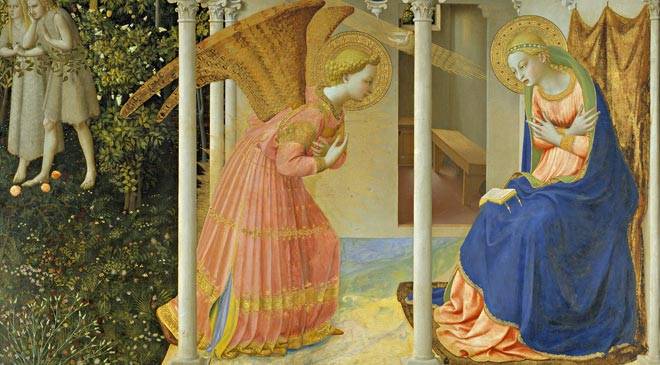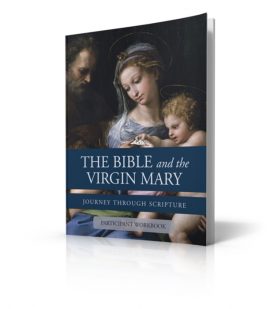
Luke, like Matthew, introduces Mary as a virgin betrothed to Joseph, a descendant of David. Luke also tells us that the angel Gabriel greets her with the words, “Hail, full of grace, the Lord is with you.” The word translated as “hail”—and which is also sometimes translated as “rejoice”—is the same word that Israel’s prophets used to begin prophecies about the promised Messiah and the joy He would bring to God’s people (Joel 2:23–24; Zech 9:9). The angel’s announcement in Luke seems to be drawn almost word for word from a prophecy of Zephaniah’s (3:14–18). Luke seems to be depicting Mary as Daughter Zion, the representative of her people called to rejoice because God has come into her midst.
Luke’s account also tells us that Mary’s Son will be the “Son of the Most High” and will be given “the throne of David his Father.” Importantly, in 2 Samuel 7, God swore to David that his son would be “a son to me.” Likewise, Gabriel promises Mary that her Son will be the “Son of the Most High” (See Mk 5:7, Lk 1:35, and 8:28). God also swore to David that his son would rule on David’s throne forever, while Gabriel promises Mary that her Son will be seated on “the throne of David his father . . . forever.”
At the conclusion of Luke’s account, Mary asks how she, being a virgin, will conceive the child. Gabriel replies: “For with God, nothing will be impossible.” An angel spoke almost those exact words to Sarah, Abraham’s wife. By using those words, Luke shows us that Mary, like Sarah, is being called to bear the Son of God’s covenant promise. Those words also connect Mary to all the other miraculous births in salvation history, including Hannah, the mother of Samuel, the priest and prophet who anointed David king of Israel. Five times in one passage, Hannah described herself as the Lord’s “maidservant.” In presenting herself as the “handmaid of the Lord” Mary recalls Hannah and her oath. Luke draws the connection between Mary and Hannah even more clearly in his account of the Visitation. When Mary goes to visit her cousin Elizabeth, she responds to Elizabeth’s greeting with a song of praise that closely resembles the prayer Hannah prayed after she conceived and bore a son.
Luke demonstrates that Jesus is the last and greatest of these births and that Mary is the greatest mother of salvation history. She is the woman who all the other great mothers of the Old Testament merely foreshadowed.
Doing this type of literary reading gives us knowledge of historical truth: Jesus was born through the Holy Spirit to a virgin named Mary. But this historical truth also conveys a divine meaning. Matthew and Luke’s accounts assume the existence of a divine plan, in which the covenant oaths God swore to Abraham and David are meant to find their ultimate fulfillment in the coming of Christ. The evangelists want to show the unity between the Old and New Testaments. This way of reading and writing is broadly known as typology. Typology connects the persons, places, and events of the Old Testament to the persons, places, and events of the New Testament. It studies how God’s works in the Old Covenant prefigure what He accomplished through Christ in the New Covenant (CCC 128).
Jesus himself taught the Apostles to understand Him by using typology in their reading of the Scriptures. Even in Jesus’ day, however, this way of reading the Scriptures was nothing new. In the Old Testament, we often find typology used to prepare Israel for its coming Savior. Isaiah, for example, spoke of a new creation and a “new exodus” (Is 11:15–16, 65:17). The New Testament writers saw each of these great “types” fulfilled in the New Covenant of Jesus. Jesus was the “New Adam” (Rom 5:14). His cross and resurrection mark a new exodus from sin into glory (Lk 9:31), and His Church is the New Jerusalem and the New Kingdom of David (Gal 4:26; Acts 1:6–9; 1 Pet 2:9; Rev 1:6).
Typology also illuminates our understanding of Mary. The New Testament writers saw her as the New Eve, the Ark of the New Covenant, and the new Queen Mother of the Kingdom of God. When we understand how the writers use typology, we find that Mary is depicted as mysteriously inseparable from the saving mission of her Son.
Learn more about Mary’s central role in salvation history in The Bible and the Virgin Mary. In the Participant Workbook, find more in-depth reflections like this one, as well as discussion questions, full-color masterpieces, Marian prayers, and more.
You Might Also Like

The Participant Workbook for The Bible and the Virgin Mary will serve as your companion for the duration of one of our most popular Bible studies. Learn more about Mary's important role in salvation history with this invaluable resource.

